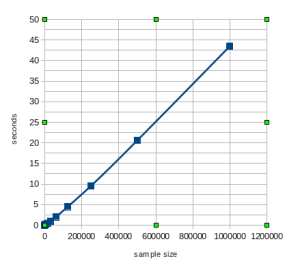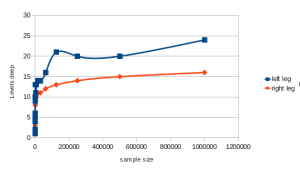Kick off of playing with trees
Feb. 14, 2011As I have stated before, I enjoy the speed at which I can prototype an idea in Ruby. Even if ultimately that idea runs better on another language. For the sake of my academics, it provides a super learning playground.
Earlier, this past week, I began reading up on papers and documentation of trees. All in an effort to differentiate the various implementations of trees, including their benefits and drawbacks. Finding AVL trees, B trees, 2-3 node, 2-3-4 node and RB trees. I decided to kick off the events with a Red-Black tree. Some of the papers I found are the generally available by Google searching.
After a lot of learning, and a little massage, I have the first of a an “academic” implementation of an RB tree (http://hashbangbash.com/~vbatts/rbtree.rb). I gravitated towards this tree first because of the type searches I am needing. While the population of this slows as it grows, the searches are ridiculously fast. I’ll get around to generating some instrumentation to graph it. For now I have the run_loop(
The insertion graphed was an O(N) climb. For doubling the number of nodes to be inserted (of random unique numbers), the time increase was just a tad more than double. The @results for run_loop(1,000,000) was
=> [[1000000, 43.4912700653076, 24, 16], [500000, 20.5859882831573, 20, 15], [250000, 9.5372850894928, 20, 14], [125000, 4.50037479400635, 21, 13], [62500, 2.01573848724365, 16, 12], [31250, 0.941669225692749, 14, 11], [15625, 0.435366868972778, 14, 11], [7812, 0.252951860427856, 13, 10], [3906, 0.0940215587615967, 11, 9], [1953, 0.043536901473999, 13, 8], [976, 0.0200107097625732, 9, 8], [488, 0.00921034812927246, 9, 6], [244, 0.00417494773864746, 10, 5], [122, 0.00190210342407227, 6, 5], [61, 0.000821590423583984, 5, 4], [30, 0.000351667404174805, 4, 3], [15, 0.000170707702636719, 4, 2], [7, 6.03199005126953e-05, 2, 1], [3, 2.57492065429688e-05, 1, 1]]
which resulted in a time climb of
Another interesting observation was the logarithmic oscillations of the depth of the left most leg.
At any rate, enjoy and feel free to send your thoughts.
Take care,
vb

